Introduction
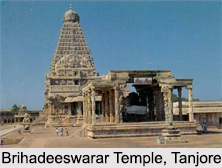 The Chola dynasty was one of the longest ruling dynasties in the history of Southern India, they utilised their prodigious wealth earned through their extensive conquests in building long-lasting stone temples and exquisite bronze sculptures. The Chola art and architecture had the influence of the Pallavas and other contemporary art and architecture schools, which in turn helped them to elevate the Dravidian form to greater heights. Discussed elaborately below are the various forms of Chola art and architecture.
The Chola dynasty was one of the longest ruling dynasties in the history of Southern India, they utilised their prodigious wealth earned through their extensive conquests in building long-lasting stone temples and exquisite bronze sculptures. The Chola art and architecture had the influence of the Pallavas and other contemporary art and architecture schools, which in turn helped them to elevate the Dravidian form to greater heights. Discussed elaborately below are the various forms of Chola art and architecture.
Art under the Cholas
The Chola art and sculpture styles are similar to that of the Pallavas, the structures in most of the temples were carved from stone and metal. They depict the socio religious ideas of the Chola period, the Nataraj sculpture is world famous not only for its beauty but also for its spiritual meaning. There is a certain kind of spiritual calmness in the sculptural representations of the Vishnu idols in the Vaishanava temples or that of the Alwars. The temples of the Imperial Cholas are covered with exquisite well composed sculptures and frescoes. The artists used the lost wax technique and followed the complete Indian Shilpa Shastra. The sculptures during this period are described as the cultural epitome of Chola period and are the best specimen of Chola art.
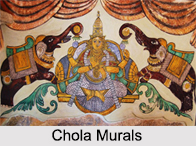 The Cholas excelled the Pallavas in the art of portrait making as well, the beautiful portraits on the walls of the Koranganatha and Nageswarasamy temples exhibit the artistry of the craftsmen of that time. The art of paintings also flourished during their time and thus the figures were painted with much realism. There were paintings on the themes of Puranas painted on the inner walls of the Raja Rajeswara Temple and Gangaikonda Cholapuram Temple and the Nataraj Temple at Chidambaram. A painting believed to be that of Marco Polo is in the Brihadeeswarar Temple at Thanjavur. There is also an imagery of Lord Shiva in the cosmic dance form with the celestial dancers which is also found on the walls of Gangaikonda Cholapuram temple.
The Cholas excelled the Pallavas in the art of portrait making as well, the beautiful portraits on the walls of the Koranganatha and Nageswarasamy temples exhibit the artistry of the craftsmen of that time. The art of paintings also flourished during their time and thus the figures were painted with much realism. There were paintings on the themes of Puranas painted on the inner walls of the Raja Rajeswara Temple and Gangaikonda Cholapuram Temple and the Nataraj Temple at Chidambaram. A painting believed to be that of Marco Polo is in the Brihadeeswarar Temple at Thanjavur. There is also an imagery of Lord Shiva in the cosmic dance form with the celestial dancers which is also found on the walls of Gangaikonda Cholapuram temple.
The Cholas also contributed to the growth of both vocal and instrumental music. Instruments such as kudamula, veena, and flute were used and the devadasis were expert musicians and singers. The classical dance forms of Bharatnatyam and Kathakali acquired its basis from under Chola patronage based on rules of the sage Bharata in Natya Shastra. Dance dramas were also performed on stages during the times of festivities and the Chola kings made endowments to promote the art of dancing. The Cholas also promoted the art of drama and the performers received honours from the Chola kings. There are several inscriptions on the walls of the temples detailing the art and culture of that period. The Chola literature spoke about these glorious cultural aspects of that era.
Architecture under the Cholas
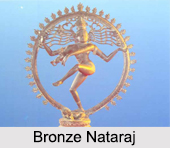 A special feature of the Chola architecture is the purity of the artistic tradition. Built in the early 11th century, the two magnificent temples at Thanjavur and the Gangaikonda Cholapuram in Tiruchirapalli District show the best of Chola art and architecture. The Dravidian feature initiated by the Pallavas acquired the classical forms and features under the Cholas such as gopurams, mandapams and vimanas. Initially, the gopuram features were more prominent but in the later stages, the vimanas took the forefront. The sanctums of the Chola temples were both circular and square in size and the walls of the inner sanctum sanatorium were beautified. On the upper side of the sanctum special vimanas are built with dome shaped sikhara and kalasa which were also there on the top of gopurams. The walls of the passage around the Brihadeeswarar Temple sanctum are covered with panels of exquisite paintings which though faint with time show vivid expression The 108 dance poses of Shiva carved on the inner walls of this temple testify to the heights attained by the Cholas in the field of art and architecture. This temple is known to be the finest creation of Chola craftsmen.
A special feature of the Chola architecture is the purity of the artistic tradition. Built in the early 11th century, the two magnificent temples at Thanjavur and the Gangaikonda Cholapuram in Tiruchirapalli District show the best of Chola art and architecture. The Dravidian feature initiated by the Pallavas acquired the classical forms and features under the Cholas such as gopurams, mandapams and vimanas. Initially, the gopuram features were more prominent but in the later stages, the vimanas took the forefront. The sanctums of the Chola temples were both circular and square in size and the walls of the inner sanctum sanatorium were beautified. On the upper side of the sanctum special vimanas are built with dome shaped sikhara and kalasa which were also there on the top of gopurams. The walls of the passage around the Brihadeeswarar Temple sanctum are covered with panels of exquisite paintings which though faint with time show vivid expression The 108 dance poses of Shiva carved on the inner walls of this temple testify to the heights attained by the Cholas in the field of art and architecture. This temple is known to be the finest creation of Chola craftsmen.
Early Chola Art in South India
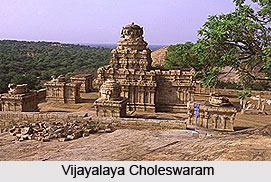 Early Chola Art in South India covers the art and architectural styles of South India, where one can find the art in temples dealing with mythology, ancient literature, epics and science.
Early Chola Art in South India covers the art and architectural styles of South India, where one can find the art in temples dealing with mythology, ancient literature, epics and science.
Pallava Art in South India
Pallava dynasty ruled the Southern part of India, in between the 3rd and 9th centuries. Pallava Dynasty in South India was the first recognisable South Indian dynasty who indulged in the pursuit of art and architectural innovations. The temples and the monuments erected during the time of Pallava rule are now the examples of art and architecture.
Pallavas Dynasty in South India was active in the changeover from rock-cut architecture to stone temples. Earlier the rock cut temples were dominant in this region. The earliest examples of Pallava constructions are rock-cut temples dating from 610 to 690 AD and structural temples between 690 to 900 AD. A number of rock-cut cave temples bear the inscription of the Pallava king, Mahendravarman I and his successors.
The greatest excellence of the Pallava architecture is the rock-cut temples at Mahabalipuram. There are excavated pillared halls and monolithic shrines known as rathas in Mahabalipuram. Early ancient and early medieval temples were mostly dedicated to Lord Shiva or Mahadeva. Kailasanatha Temple in Kanchipuram and the Shore Temple built by Narasimhavarman II, rock cut temple in Mahendravadi by Mahendravarman are fine examples of the Pallava style temples.
The temple of Nalanda Gedige in Kandy, Sri Lanka is another example of art and architecture. The famous Tondeswaram temple of Tenavarai and the ancient Koneswaram temple of Trincomalee were patronized and structurally developed by the Pallavas in the 7th century.
Dravidian Temple Architecture in South India
The first seeds of Dravidian temple architecture in Tamil Nadu were possibly sown during this period. The temple architecture of Dravidian temple evolved from the early cave temples and monolith temples of Mamallapuram to the Kailasanatha and Vaikuntaperumal temples of Kanchipuram. This architecture style of the Dravidan art formed the foundation of Chola Dynasty who were in close contact with the Pallavas during their periods of decline.
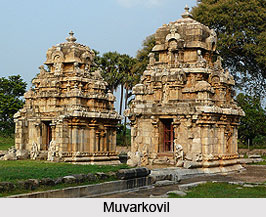
Early Chola Art
The early Chola Dynasty built the numerous temples dedicated to Lord Shiva or Mahadeva. Aditya I and Parantaka I were prolific builders for their faith. The inscriptions of Aditya I record that he built a number of Hindu temples along the banks of the Kaveri River. These Hindu temples were much smaller in comparison to the huge colossal structures of the later Cholas and were probably brick structures rather than stone.
Vijayala Choleswaram
Vijayala Choleswaram near Pudukkottai in Tamil Nadu is an instance of a surviving early Chola building. The style of this Chola building structure clearly shows Pallava influences in the design. It has an unusual arrangement of a circular garba griha, where the deity resides within a square prakara - circumbulatory corridor. Above this rises the vimana or the tower in four diminishing storeys of which the lower three are square and the top circular. Each level is separated from the next by a cornice. The whole structure of the temple is surmounted by a dome which in turn is topped with a stone kalasa - a crest.
Paintings of Chola Art
Very faint traces of paintings can be seen inside on the walls. These paintings are dated not earlier than the 17th century.
Koranganatha Temple
Koranganatha Temple at Srinivasanallur near "Hirapalli" is an example of the period of Parantaka I. Koranganatha Temple at Srinivasanallur is situated on the banks of the Kaveri River, and is a small temple with beautiful sculptures on every surface. The base of the wall has a row of sculpted mythical animals that were a unique feature of Chola example architecture. The first floor of Koranganatha Temple is made of bricks which have been plastered.
Muvarkovil Temple
Muvarkovil Temple of three, also in the Pudukkottai area was built by a feudatory of Parantaka Chola II during the second half of the tenth century. As the name suggests, the temple complex of Muvarkovil Temple has three main shrines standing side by side in a row, along the north-south direction, facing west. Out of these three, only two, the central and southern vimanams, which are the towers are now extant. Of the third or the northern shrine, the basement alone remains. The architectural style of the temples exhibits clear concordance with the later Chola temples.
Wax techniques of Chola Art
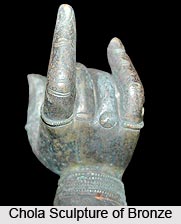 Wax techniques in Chola art are used by the artisans of Chola Dynasty. The Cholas were great warriors with a magnanimous nature and by the 10th century AD that is the early phase of medieval era. They not only took the holy city of Madurai from Pandya Dynasty, but also they moved further down the South to invade Sri Lanka. Up in the north-east Deccan too, the Cholas Dynasty subjugated the re-emerging Chalukyan powers.
Wax techniques in Chola art are used by the artisans of Chola Dynasty. The Cholas were great warriors with a magnanimous nature and by the 10th century AD that is the early phase of medieval era. They not only took the holy city of Madurai from Pandya Dynasty, but also they moved further down the South to invade Sri Lanka. Up in the north-east Deccan too, the Cholas Dynasty subjugated the re-emerging Chalukyan powers.
The art in Chola Dynasty reached at its height in the 11th Century. This is known as mature Chola art in India. The Chola period bronzes were created using the lost wax technique. It is known in artistic terms as "Cire Perdue". The Sanskrit Shilpa texts call it the Madhu Uchchishtta Vidhana.
Use of Bee wax in Chola art
The beeswax and kungilium, a type of camphor mixed with a little oil and kneaded well. The figure is sculpted from this mixture fashioning all the minute details. This is the wax original model in Chola art. The entire figure of wax technique is then coated with clay made from termite hills until the mould is of a necessary thickness. Then the whole thing is dried and fired in an oven with cow-dung cakes. The wax model melts and flows out, while some of it vaporises.
Use of Pancha Loham in Wax Technique
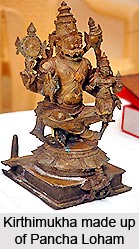 The metal alloy of bronze is melted and poured into the empty clay-mould. This particular bronze alloy is known as Pancha Loham. When the metal has filled all fissures and has settled and hardened and cooled, the mould is broken off. The bronze figure thus obtained is then cleaned, finer details are added, and blemishes are removed, smoothened, and polished well. Hence each bronze icon is exclusive and the mould cannot be used to create copies.
The metal alloy of bronze is melted and poured into the empty clay-mould. This particular bronze alloy is known as Pancha Loham. When the metal has filled all fissures and has settled and hardened and cooled, the mould is broken off. The bronze figure thus obtained is then cleaned, finer details are added, and blemishes are removed, smoothened, and polished well. Hence each bronze icon is exclusive and the mould cannot be used to create copies.
Elegant Design of Bronze art in Chola Times
The forms of Chola bronze are very synthetic. They are devoid of intricate ornaments and designs in comparison with the subsequent bronze of the Vijayanagar Empire and Nayakas period. There is gentle grace, a restrained and quiet elegance, an ethereal, out-worldly beauty and above all else - a life that pulsates and thereby enlivens the bronze sculpture in later Chola period. By means of the facial expressions, the gestures or mudras of the bronze sculptures, the overall body posture and other accompanying bronzes that one can imagine the surroundings and the religious context of the figure of the god or goddess; what instrument or weapon he or she is holding; what he or she is leaning on; and what he or she is doing or about to do.
Rishabaandhika or Vrishabavahana Murthy Pose
The Rishabaandhika or the Vrishabavahana murthy pose is one of the most well known bronze sculptures in Chola times. Lord Shiva or Mahadeva is standing with one leg youthfully crossed across the other and his arm elegantly flexed and raised as if resting or leaning on something. In this elegant posture, it can be surmised that the youthful and athletic Shiva is leaning on his bull-vahana, Nandi on whose shoulders He is resting His arm.
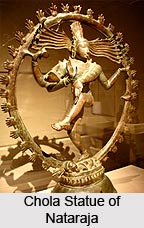
Nataraja or Adavallar Bronze Icon
The most famous of all the bronze icons of Chola art is Nataraja or Adavallar. The symbolism presents Shiva as the Lord of the Cosmic Dance of creation and destruction. He is active, yet aloof, like the gods on the Parthenon Frieze. Lord Shiva is surrounded with a circle of flames representing the universe, whose fire is held in Shiva`s left rear palm. His left front arm crosses his chest, the hand pointing in "elephant trunk" position to his upraised left foot, which signifies liberation. His right foot tramples the dwarf Apasmara, who represents ignorance. Lord Shiva`s right front hand is raised in the "fear-not" gesture of benediction (abhaya mudra), while his right rear hand holds a drum with which he beats the measure of the dance. The snake, an emblem of Shiva, curls around his arm. His hair holds the crescent moon - another emblem - and a small image of River Ganga, the river-goddess whose precipitous fall from heaven to earth is broken by Shiva`s matted locks. Lord Shiva as Nataraja or Adavallar is also escorted by his consort Shivakami.



















